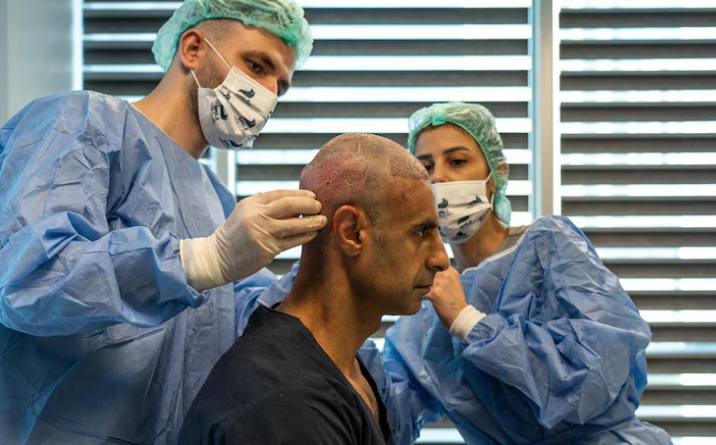Hair loss is big business in medical tourism, and Türkiye’s clinics are cashing in
On the streets of Istanbul, it is impossible to miss them: clusters of young men with their heads wrapped in bandages, their scalps dotted with a shiny red hue. Throughout the year, they can be seen admiring the beauty of the Blue Mosque, bargaining at the Grand Bazaar, and waiting in line at the airport check-in counter.
Most of them are not Turkish and only stay in the city for a short period, just enough time to recuperate from their hair transplant surgeries before heading back home. However, they all share a common goal: to combat their hair loss. Paymaan Shahrokhey, who traveled to Istanbul from Sydney last summer after noticing his receding hairline, explained, “Hair loss runs in my family, and I decided to take advantage of our trip to Europe by getting the procedure done.”
Over the past two decades, Turkey has emerged as a hub for hair transplants, a cosmetic surgery that involves extracting healthy hair follicles from the back of the head and implanting them in areas with hair loss.
According to tourism officials, hundreds of thousands of predominantly young men embark on a pilgrimage from various parts of the world each year. This pilgrimage is aimed at contributing to an industry that generated a staggering $3 billion in revenue in 2022.
While the cost of the procedure in Australia can exceed $20,000, in Türkiye it ranges from a mere tenth to a quarter of that amount. Despite the lower cost, Türkiye still maintains high standards of care, making it an attractive option for many.
Clinics in Türkiye fiercely compete for customers, particularly from the Arab world, the United States, and Europe. They entice potential clients with all-inclusive packages and employ flashy marketing techniques to sell their services.
Promotional videos proudly showcase satisfied customers, months after their procedures, confidently displaying their lush heads of hair. Their partners, wives, and girlfriends marvel at the transformation.
It has been reported that renowned personalities such as Lewis Hamilton, Steve Carell, Matthew McConaughey, and Gordon Ramsay have undergone this treatment.
One such clinic, the Smile Hair Clinic, is located in a multi-storey building overlooking a bustling highway on Istanbul’s Asian side. The waiting area of this clinic resembles the lobby of an upscale hotel rather than a typical medical facility.
Glass chandeliers are suspended from the ceiling, creating an elegant atmosphere as staff attentively offer refreshments to the customers who patiently await their appointments.
In an adjacent room, designed to resemble a barber shop, a unique feature awaits. This space serves as a social media studio, where customer testimonials are recorded and shared with the company’s extensive Instagram following, which boasts over a million loyal followers.
Apart from the skilled surgical team, the clinic also employs a dedicated group of six individuals who specialize in promoting content through various online channels. It is through these channels that the majority of new clients are discovered and drawn to the clinic.
The sales staff openly acknowledge that they are in the business of “selling confidence,” often engaging directly with the wives or girlfriends of potential customers. They understand the profound impact that hair loss can have on an individual’s self-esteem and strive to provide a solution that can truly transform lives.
“It may not be a significant concern for some individuals to experience baldness, but the majority of those who seek our services often express sentiments like, ‘Oh, you’ve changed my life,'” shared Smile co-founder and hair transplant surgeon, Gökay Bilgin.
He further emphasized the importance of aesthetics in today’s society, stating, “For many, it is crucial to have the ability to capture beautiful photographs or even engage in intimate moments with confidence.”
At its core, a hair transplant offers the illusion of natural hair growth by strategically placing grafts to create the appearance of a full head of hair. However, it is essential for patients to understand that proper care during the recovery period is crucial. Failure to do so can result in damage to the newly implanted follicles.
In the initial weeks following the procedure, patients are instructed to refrain from showering or engaging in strenuous physical activities. This precaution is necessary to prevent water pressure and sweat from dislodging the newly implanted follicles.
Upon returning home, many patients find that their sleep is affected as they must avoid lying flat in bed to prevent contact with bedsheets and pillows, which could potentially disrupt the progress made during the transplant.
On the day of Mr. Shahrokhey’s surgery, the skilled staff began by shaving his head. They then used a black marker to carefully outline the areas where the new hair grafts would be placed, ensuring precision and optimal results.
In an upper-floor theatre, the patient’s scalp underwent a local anaesthetic injection before the surgeon initiated the initial phase of the procedure: extraction.
Methodically, between 3,000 and 5,000 hair follicles were carefully removed from healthy areas at the back of the patient’s head and placed into Petri dishes, prepared for implantation.
Across the room, a television displayed a recorded message featuring a man dressed in white, cautioning against sudden movements during the surgery.
“If you experience any discomfort or need a moment to catch your breath, please inform the team and we will provide a brief break,” the man conveyed in English through the screen.
Meanwhile, in the waiting area, several men sat idle, engrossed in their phones or gazing out the window, their heads wrapped in bandages from the morning’s procedures.
“It’s quite an unusual sensation,” remarked Alex, who had traveled from London for the treatment. “It feels as though I’m wearing a helmet. I can hardly perceive any sensation in my head.”
Following the procedure, Alex faced a recovery period spanning several weeks, during which he would be unable to shower or sleep on his back. If all progressed as expected, he would witness the complete results of the treatment in approximately 18 months.
“When socializing with friends, I was always conscious of the wind blowing and revealing the areas where I had no hair,” he shared.
Back in Mr. Shahrokhey’s room, three surgical staff members gathered around his head, meticulously placing the plucked hair follicles into freshly drilled holes on the crown. Working silently, their arms moved in practiced, rhythmic motions, making the process appear effortless to an untrained observer.
Hair is a lucrative business, but transplants aren’t the only option
In a country plagued by poor working conditions and meager wages within the public healthcare system, private clinics catering to affluent foreigners have become an enticing prospect for many individuals.
The rapid growth of this industry in Turkey has inadvertently given rise to illicit clinics that circumvent regulations and employ inadequately trained personnel, resulting in procedures that can have disastrous consequences. For foreign clients, distinguishing between reputable and trustworthy clinics can often be a challenging task.
According to the International Society of Hair Restoration Surgery, a non-profit organization based in Chicago, a botched procedure performed by unlicensed staff, who frequently lack malpractice insurance coverage, can lead to perilous and irreversible health complications.
These issues, the association asserts, are not confined solely to Turkish clinics or exclusively affecting men, but are prevalent in countries worldwide.
Even at esteemed clinics, hair transplants do not provide a flawless solution for every individual grappling with hair loss.
Female pattern hair loss, the most prevalent form of hair loss in women, is distinct from male pattern baldness. Men typically experience hair loss concentrated at the crown, while women generally face overall thinning across the scalp, making it challenging to identify suitable donor areas for transplantation.
Gina, a retired school teacher from the north-eastern United States, who underwent a hair transplant procedure after noticing thinning in her early 20s, advises against it for women.
Hair transplants for women are less common and not as heavily promoted as they are for men, posing unique medical risks. Despite initial signs of regrowth in the first six months post-surgery, Gina’s hair began falling out again, leaving her feeling deceived.
She expressed feeling like she was back to square one, emphasizing the emotional impact of losing hair, a significant part of many women’s identity. To cope with her unsuccessful surgery, Gina now wears a “hair topper” and connects with other women facing similar challenges on Instagram. In the grand scheme of things, it may seem trivial, but it has significantly enhanced my self-assurance. SOURCE: Tom Joyner from ABC NEWS




